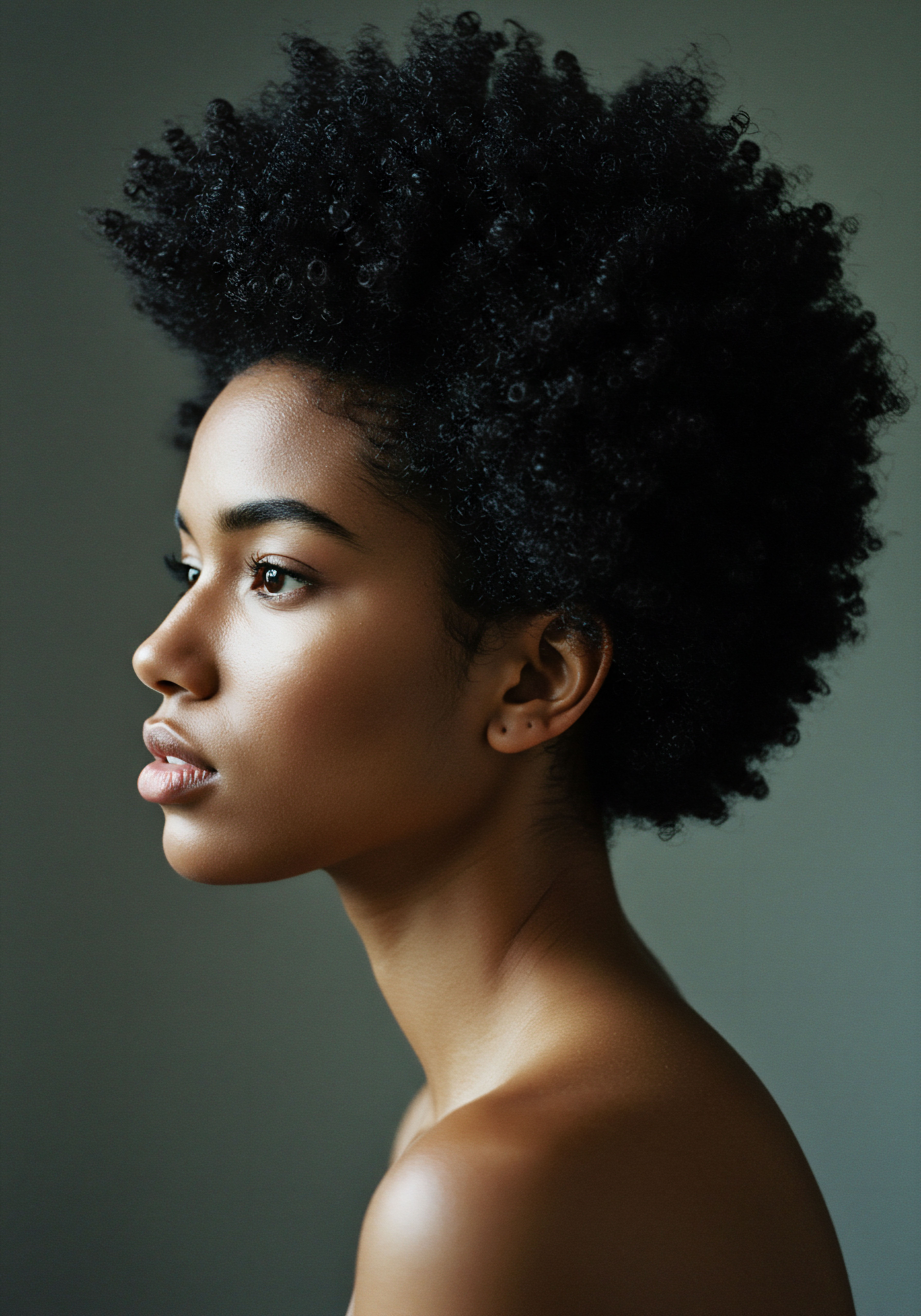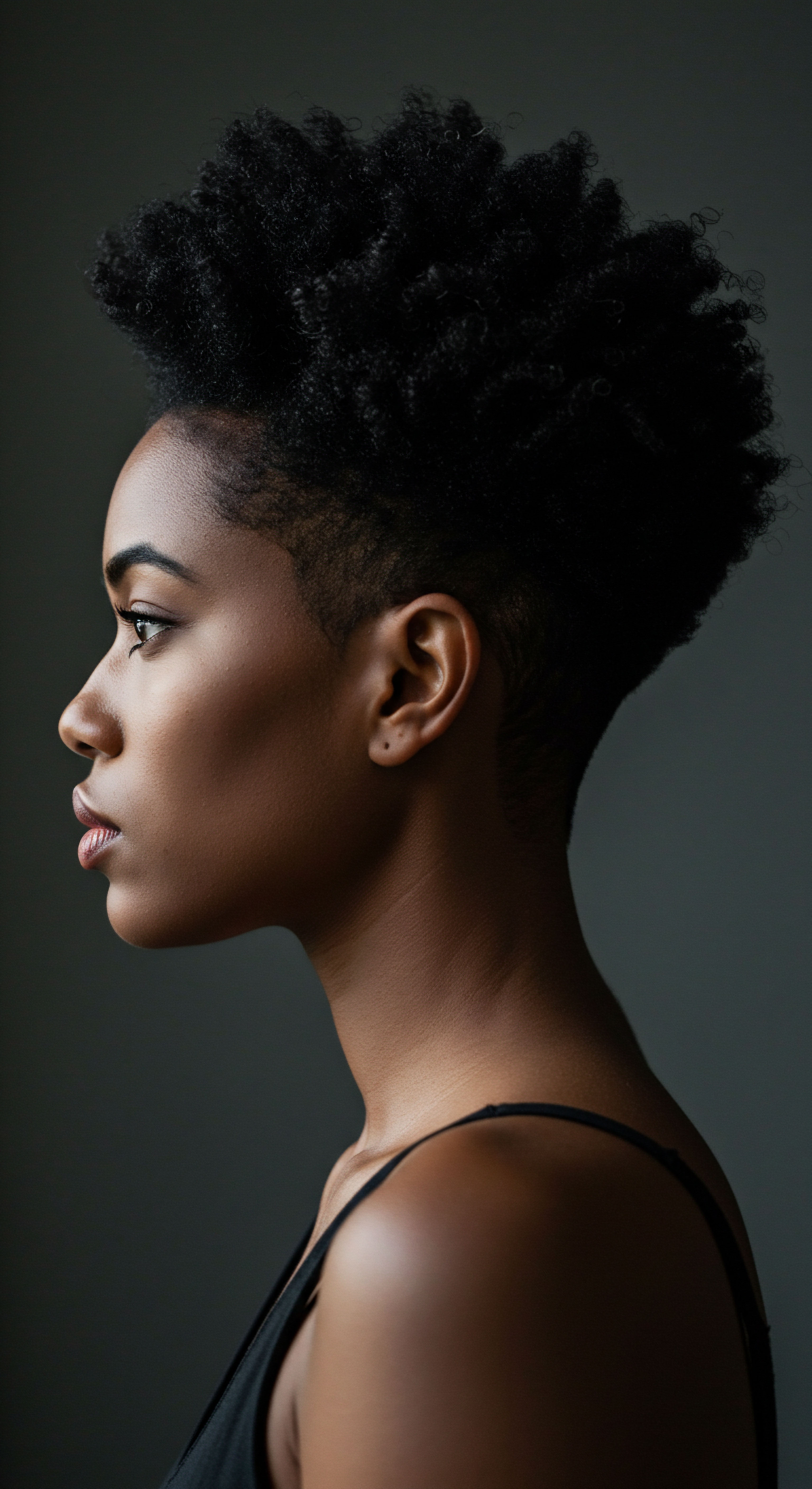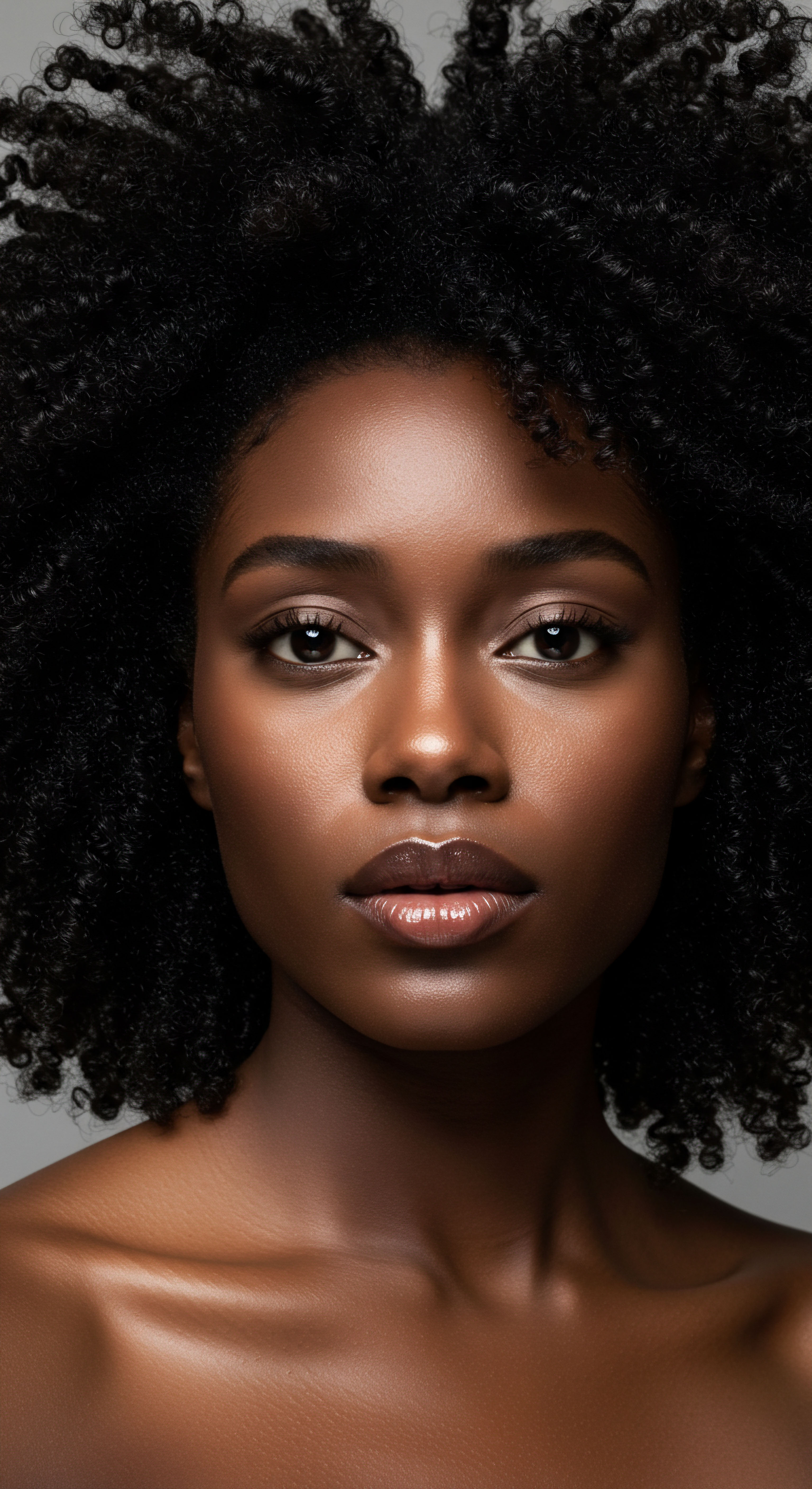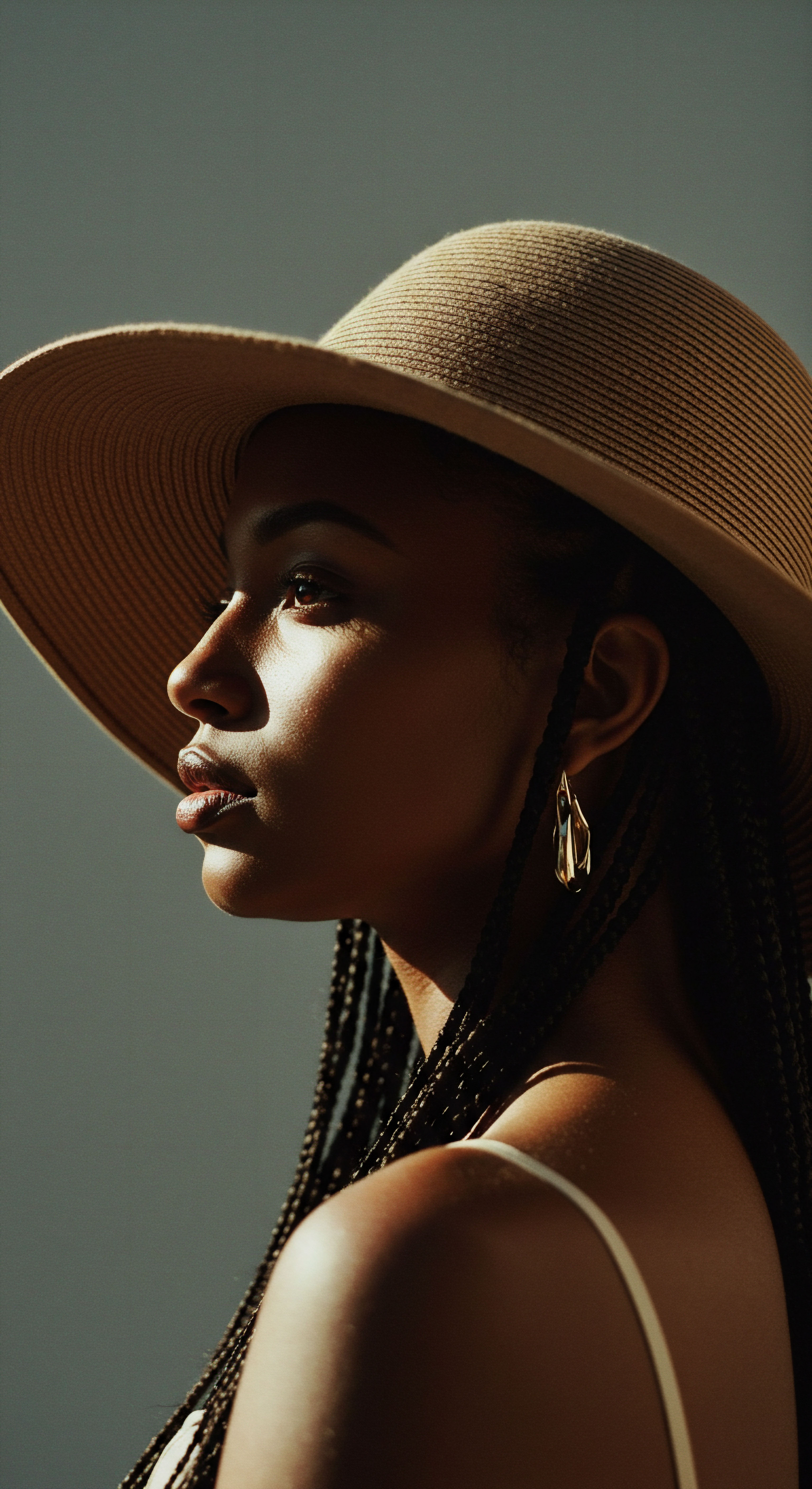
Roots
Our hair, in its countless forms and textures, carries stories whispered across generations. It is a living chronicle, a connection to ancestral wisdom, holding echoes of practices that predate our modern understanding of care. To truly appreciate contemporary scalp well-being, we must first gaze backward, recognizing the profound foundations laid by those who came before us. Their daily routines, often steeped in the natural world and cultural significance, offer not merely quaint historical footnotes, but potent lessons for our own hair journeys.
For Roothea, this exploration begins at the very ground of being – the scalp. It is the soil from which our strands grow, demanding thoughtful attention. Historical practices, far from being simplistic, reveal a deep, intuitive understanding of this living surface, long before microscopes revealed cellular structures. We find cultures across the globe tending to their scalps with a reverence that often surpasses our current hurried routines.

Ancient Reverence for Scalp Vitality
In civilizations spanning continents, hair was never simply an adornment; it was a symbol of health, status, and identity. This perception naturally extended to the scalp, its hidden source. Ancient Egyptians, for instance, were deeply concerned with hair preservation and growth, often employing remedies to combat baldness and graying. Their practices, documented in texts like the Ebers Papyrus (dating to about 1550 BC), included a variety of topical applications.
These often featured animal fats from sources like hippopotamus, crocodile, and lion, blended into pomades for application to the scalp. While some of these ingredients may seem unusual to us today, they speak to an earnest desire to nourish the scalp and stimulate growth, utilizing the resources available in their environment.
Similarly, in ancient India, the wisdom of Ayurveda provided a holistic framework for hair and scalp care. This ancient healing system, viewing the body as a balanced interplay of elements, saw hair health as a reflection of overall well-being. Ayurvedic texts outlined the use of natural ingredients like Amla (Indian gooseberry), Shikakai (soap pod), and Neem for cleansing and conditioning.
These botanical agents were not merely superficial cleansers; they were chosen for their therapeutic properties, aiming to nourish the scalp and support healthy growth. The Ayurvedic perspective understood that the health of hair begins with the food we eat and the internal balance of our systems.
Past hair care practices often reveal a profound, intuitive grasp of scalp health, emphasizing natural elements and a holistic view of well-being.

The Roots of Cleansing and Balance
Our modern concept of daily shampooing is a relatively recent phenomenon, largely gaining widespread acceptance in the 20th century. Historical approaches to cleansing were far more varied and often less frequent, yet they prioritized scalp hygiene. Medieval Europeans, for example, did not use modern shampoos. Instead, they relied on dry shampoos made from herbs and powders to absorb excess oil and dirt.
They also employed vigorous brushing and combing to distribute natural oils, clean the hair, and exfoliate the scalp. This highlights a different understanding of cleanliness, one that focused on mechanical removal of impurities and the balance of natural oils, rather than stripping them away with harsh detergents.
The use of natural clays and plant extracts for cleansing is another common thread across ancient cultures. These materials often possess gentle absorbent properties, removing impurities without disrupting the scalp’s delicate balance. The idea was to support the scalp’s inherent functions, not to override them. This contrasts sharply with some contemporary products that can strip the scalp of its natural oils, leading to dryness or, paradoxically, overproduction of sebum.
Consider the practices of various cultures and their approaches to scalp cleansing:
- Ancient Egypt ❉ Used natural ingredients like henna, honey, and almond oil for cleansing and conditioning.
- Medieval Europe ❉ Employed herbal infusions and vinegar rinses to cleanse the scalp and maintain shine. Daily washing was less frequent, with dry shampoos and thorough brushing serving as primary methods.
- Indigenous African Traditions ❉ Utilized plant extracts and oils for both cleansing and treating scalp conditions.
These historical methods remind us that scalp health is not solely about what we apply, but also how we interact with our hair’s natural rhythms and needs. The careful selection of ingredients, often locally sourced and deeply understood, allowed for targeted care that respected the scalp’s ecosystem.

Ritual
Stepping from the foundational understanding of the scalp, we arrive at the rhythmic, often daily, practices that shaped historical hair care. These were not mere tasks, but often deliberate rituals, imbued with intention and a quiet wisdom. They offer a tangible connection to the practical ways people nurtured their scalps, providing actionable insights for our own modern routines. This section delves into these consistent applications, reflecting on how their sustained performance cultivated healthy scalp environments.

The Significance of Scalp Massage
Across diverse historical settings, the gentle yet firm manipulation of the scalp stood as a cornerstone of hair care. From the ancient Indian practice of Champissage, or Indian Head Massage, to daily routines in other cultures, the physical act of massaging the scalp was recognized for its profound benefits. This was not simply a soothing gesture; it was a deliberate technique aimed at improving the scalp’s condition.
Modern science now provides a compelling rationale for these historical practices. Scalp massage stimulates blood flow to the hair follicles, ensuring a more robust delivery of oxygen and essential nutrients. This enhanced circulation can promote healthier and stronger hair growth. A small 2016 study found that regular, four-minute scalp massages daily for 24 weeks led to increased hair thickness in nine men.
Further research in 2019, based on survey responses from 340 participants who performed twice-daily scalp massages for hair loss, indicated that approximately 69% reported an improvement in their alopecia. This data suggests that the intuitive practices of old hold measurable physiological benefits, far beyond simple relaxation.
Consider the elements of traditional scalp massage that we can adapt:
- Consistent Pressure ❉ Not too harsh, but firm enough to stimulate the subcutaneous tissue.
- Circular Motions ❉ Using fingertips to move the scalp gently over the skull.
- Regularity ❉ Daily or frequent application to maintain continuous stimulation.
The historical emphasis on touch and mindful application reminds us that true care is not always about complex products, but often about consistent, simple gestures that support the body’s natural processes.

Ancient Oils and Their Sustained Presence
Before the era of synthetic formulations, natural oils were the elixirs of scalp health. Olive oil in ancient Greece and Rome served as a multifunctional conditioner and fragrance, often infused with aromatic herbs. In ancient India, coconut oil, amla oil, and brahmi oil were staples, chosen for their abilities to nourish the scalp, strengthen roots, and impart luster. These oils were not just for superficial shine; they were selected for their perceived therapeutic qualities, acting as emollients, anti-inflammatory agents, or even purported stimulants for growth.
The application of oils often went hand-in-hand with massage, creating a potent combination. The oil provided lubrication, allowing for deeper manipulation of the scalp, while also delivering its beneficial compounds directly to the skin and follicles. This tradition continues in many parts of the world, particularly in cultures with a history of using natural ingredients.
For example, coconut oil has documented antibacterial activity, capable of disintegrating the lipid membrane of bacteria like Propionibacterium acnes and Staphylococcus aureus. This scientific validation provides a contemporary lens through which to appreciate the long-held wisdom of these practices.
The historical use of scalp massage and natural oils, now supported by contemporary studies, highlights simple, consistent methods for promoting scalp vitality.
| Oil Source Coconut Oil |
| Historical Use Cleansing, conditioning, hair strength in ancient India. |
| Contemporary Relevance for Scalp Health Antibacterial activity, emollient, reduces protein loss. |
| Oil Source Olive Oil |
| Historical Use Conditioning, fragrance in ancient Greece and Rome. |
| Contemporary Relevance for Scalp Health Moisturizing, antioxidant properties for scalp. |
| Oil Source Amla Oil |
| Historical Use Hair growth, preventing hair fall in Ayurveda. |
| Contemporary Relevance for Scalp Health Rich in Vitamin C, antioxidant, supports collagen production. |
| Oil Source Neem Oil |
| Historical Use Dandruff, lice treatment in Ayurveda. |
| Contemporary Relevance for Scalp Health Antifungal, antibacterial properties for scalp conditions. |
| Oil Source These traditional oils offer a gentle, natural approach to scalp care, rooted in centuries of observation. |

The Rhythm of Cleansing
The frequency of hair washing in historical contexts varied significantly, often influenced by cultural norms, available resources, and individual preferences. Unlike today’s common practice of daily or near-daily washing, many ancient societies cleansed their hair less frequently. Medieval people, for instance, washed their hair perhaps once a month, relying on thorough brushing and head coverings to maintain cleanliness.
This difference in frequency challenges the modern assumption that more washing automatically equates to better scalp health. For some, less frequent washing, coupled with proper mechanical cleansing (like brushing) and the use of balanced natural conditioners, allowed the scalp’s natural oils to regulate without constant stripping. This approach may have contributed to a more stable scalp microbiome, a concept gaining recognition in contemporary dermatological research.
The scalp’s natural sebum, while sometimes perceived as “greasy,” plays a protective role, maintaining the skin barrier and offering a degree of antimicrobial defense. Over-washing can disrupt this delicate balance.
A study by Punyani et al. (2021) indicated that cleansing hair 5-6 times per week led to the highest overall satisfaction with hair and scalp conditions, including hair loss, fragility, softness, and luster. Interestingly, this study also noted that daily shampooing did not reduce scalp lipid concentrations, suggesting that well-formulated shampoos may not strip natural oils as much as previously thought.
However, the historical context reminds us that alternatives existed and were effective, particularly for those with textured hair types which tend to be drier and benefit from less frequent washing. The lesson here is not necessarily to abandon modern cleansing, but to reconsider the ideal frequency for individual scalp needs, perhaps learning from historical rhythms that prioritized equilibrium.

Relay
As we move beyond the foundational practices and daily rituals, a deeper examination reveals the intricate interplay of science, culture, and the profound impact of historical hair care on contemporary scalp well-being. This section aims to unravel the complexities, drawing upon research and scholarship to illuminate the “why” behind the enduring lessons from antiquity. We will explore how traditional knowledge, once dismissed as anecdotal, finds surprising validation in modern scientific inquiry, particularly for textured hair.

Can Traditional Remedies Offer Solutions for Hair Loss?
Hair loss, a concern across millennia, prompted a vast array of historical treatments, some of which seem bizarre by today’s standards. Ancient Egyptians used mixtures including fats from lions, hippopotamuses, and crocodiles for baldness. Julius Caesar, troubled by thinning hair, reportedly tried a concoction advised by Cleopatra, involving ground-up mice, horse teeth, and bear grease, which proved unsuccessful. These examples, while curious, highlight a persistent human desire to combat hair loss, leading to experimentation with available natural resources.
While many ancient remedies for hair loss were ineffective, others, particularly those involving botanical extracts, show more promise when viewed through a contemporary lens. Traditional Chinese Medicine (TCM), for instance, has a history of treating hair loss that dates back two thousand years to the Qin Dynasty. TCM understands hair health as a reflection of the state of internal organs, particularly the Kidney and Liver, which are thought to store “Essence” and “Blood” essential for hair growth. External applications in TCM often involve herbal decoctions or medicinal wines applied to the scalp to stimulate follicles and improve blood flow.
A particularly interesting, if still debated, traditional practice is the use of Fermented Rice Water. Historically used by women in the Heian period of Japan (794 to 1185 CE) and the Yao women of Huangluo Village in China, who are known for their remarkably long hair, fermented rice water is believed to enhance hair strength, shine, and even prevent graying.
What does modern research suggest about this ancient practice? A 2022 systematic review of ten studies concluded that products containing rice bran are promising for hair growth. Rice bran extract, derived from Oryza sativa, contains compounds like γ-oryzanol, tocopherols, tocotrienols, and various fatty acids.
Some of these, such as γ-oryzanol and linoleic acid, have been shown to promote hair growth in animal studies, while others like phytosterols can inhibit 5α-reductase activity, an enzyme linked to hair loss. The anti-inflammatory properties of anthocyanin polyphenols in rice bran also reduce pro-inflammatory interleukins, potentially benefiting scalp health.
However, it is important to acknowledge that while anecdotal evidence is strong and some scientific mechanisms are being explored, the overall scientific evidence specifically on fermented rice water’s efficacy for hair growth remains limited, with some dermatologists expressing concern that heavy starches could potentially damage hair. This serves as a potent example of how historical practices can provide a starting point for modern scientific inquiry, revealing compounds and methods that warrant deeper investigation.
The historical use of fermented rice water for hair, while requiring more rigorous scientific validation, presents a compelling example of ancient wisdom aligning with modern biochemical understanding of botanical compounds.

The Unseen World of the Scalp Microbiome
While ancient cultures lacked the tools to visualize microorganisms, their practices often inadvertently supported a balanced scalp microbiome. The frequent use of natural clays, herbal rinses, and oils, coupled with less frequent harsh washing, would have created an environment conducive to beneficial microbial populations. Many traditional plants used for hair care, such as Neem or certain African botanicals, possess inherent antimicrobial or anti-inflammatory properties. For example, Achyranthes aspera roots were used to cure dandruff, and Allium cepa (onion) juice was applied to eradicate dandruff and lice.
The scalp microbiome, a complex community of bacteria, fungi, and viruses, plays a critical role in scalp health. An imbalance in this ecosystem can contribute to conditions like dandruff, seborrheic dermatitis, and even hair loss. Contemporary research is increasingly focused on understanding and modulating this microbiome for optimal scalp health. The historical emphasis on gentle cleansing, natural ingredients, and scalp stimulation through massage may have unconsciously fostered a diverse and stable microbial environment, preventing the overgrowth of problematic species.
The contrast between historical approaches and the modern inclination towards aggressive cleansing becomes stark here. Over-shampooing with harsh detergents can strip the scalp’s protective lipid barrier and disrupt the delicate microbial balance, potentially leading to irritation and dysbiosis. The medieval practice of relying on mechanical cleaning with combs and brushes, alongside less frequent water washes, effectively distributed natural oils and exfoliated dead skin, which could have maintained a healthier microbial balance than constant stripping.
| Historical Practice Less Frequent Washing |
| Microbiome Impact (Hypothesized) Allows natural sebum and beneficial microbes to stabilize. |
| Contemporary Parallel/Lesson "No-poo" movement, gentle sulfate-free cleansers, focus on scalp balance. |
| Historical Practice Herbal Rinses/Clays |
| Microbiome Impact (Hypothesized) Introduces beneficial compounds, gentle cleansing, avoids stripping. |
| Contemporary Parallel/Lesson Botanical extracts in modern scalp treatments, prebiotics/probiotics in hair care. |
| Historical Practice Scalp Massage with Oils |
| Microbiome Impact (Hypothesized) Increases circulation, distributes natural oils, potential antimicrobial properties of oils. |
| Contemporary Parallel/Lesson Scalp serums, massage tools, oil treatments for scalp stimulation and health. |
| Historical Practice Protective Styling |
| Microbiome Impact (Hypothesized) Reduces environmental exposure and mechanical stress on scalp. |
| Contemporary Parallel/Lesson Braids, twists, wraps to protect scalp from sun and friction. |
| Historical Practice Many traditional methods, while not scientifically articulated at the time, likely contributed to a thriving scalp ecosystem. |

Beyond the Surface ❉ Holistic Views on Scalp Health
What if historical views on hair and scalp health were more encompassing than our current segmented approaches? In ancient cultures, the physical condition of hair was often linked to broader aspects of life ❉ spiritual well-being, social status, and even rites of passage. In ancient Greece, hair styles and care were deeply tied to identity, age, and marital status.
Spartan brides shaved their heads as part of wedding rituals, while Athenian brides engaged in elaborate washing and binding of hair. This cultural significance underscores that hair was not merely a biological entity but a profound extension of self and community.
This holistic understanding, particularly evident in systems like Ayurveda and Traditional Chinese Medicine, prompts us to reconsider our own contemporary approach. Are we addressing scalp health in isolation, or are we recognizing its connection to diet, stress, environmental factors, and overall bodily balance? Traditional systems often prescribed internal remedies, dietary adjustments, and stress-reducing practices alongside topical applications for hair and scalp issues.
For instance, in TCM, the quantity and quality of hair reflect the state of the Zang Fu organs, meaning that balancing these internal organs is vital to avoid premature graying, dryness, and hair thinning. This suggests that external scalp issues might signal internal imbalances.
This perspective presents a challenge to the often reductionist modern view that seeks a single product or quick fix for scalp concerns. The wisdom of past societies suggests a patient, sustained approach, recognizing the deep interconnectedness of body, mind, and spirit in the quest for true vitality. Lessons from historical hair care invite us to slow down, listen to our bodies, and perhaps re-engage with the natural world around us for gentle, yet powerful, solutions.

Reflection
As we close this exploration of historical hair care, a quiet realization settles ❉ the wisdom of the past, often veiled by time, holds profound insights for our contemporary quest for scalp well-being. The gentle hands of ancestors, working with earth’s bounty, remind us that true care extends beyond the superficial. It beckons us to reconnect with elemental practices, to honor the natural rhythms of our bodies, and to view our hair not as a separate entity, but as a living part of our story, deeply rooted in heritage and health.

References
- Summer, R. (2022). Ayurvedic Hair Care Handbook for Natural Hair. (Self-published, available on Amazon).
- Koyama, T. Kobayashi, K. & Hama, T. (2016). Standardized scalp massage results in increased hair thickness by inducing stretching forces to dermal papilla cells in the subcutaneous tissue. eLife, 5, e17904.
- Punyani, A. & Gupta, A. (2021). Prevalent Practices and Perceptions in Hair Cleansing. Journal of Clinical and Diagnostic Research, 15(7), ZC01-ZC04.
- Zhao, J. & Zhang, Y. M. (2014). Historical evolution on hair loss in treatment with traditional Chinese medicine. World Journal of Integrated Traditional and Western Medicine, 9(1), 8-11.
- Suryawanshi, N. S. & Jadhav, V. P. (2021). Ethnopharmacological plants used for hair treatment by tribals of Dharampur Taluka, Gujarat. World Journal of Pharmacy and Pharmaceutical Sciences, 10(1), 1227-1234.
- Ghasemi, M. & Khoshnood, M. (2022). Efficacy of Acupuncture and Moxibustion in Alopecia ❉ A Narrative Review. Frontiers in Medicine, 9, 874026.
- Al-Rubaye, A. H. & Salman, A. (2018). Role of the Hair in Ancient Egypt. International Journal of Tourism and Hospitality Management, 1(1), 81-89.
- McMullen, R. L. & Dell’Acqua, G. (2023). History of Natural Ingredients in Cosmetics. Cosmetics, 10(2), 52.
- Parry, S. (2017). Hair loss and Masculinity in Ancient Rome; or Why do Eunuchs not go bald? (Blog post on Medium).
- Llewellyn-Jones, L. (2007). House and Veil in Ancient Greece. British School at Athens Studies, 15, 249-258.
- Akinwande, K. et al. (2024). A Review Of Indigenous Therapies For Hair And Scalp Disorders In Nigeria. Journal of Dermatology and Dermatologic Surgery .